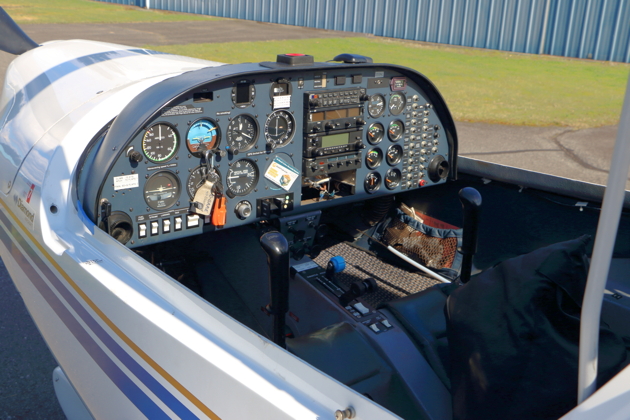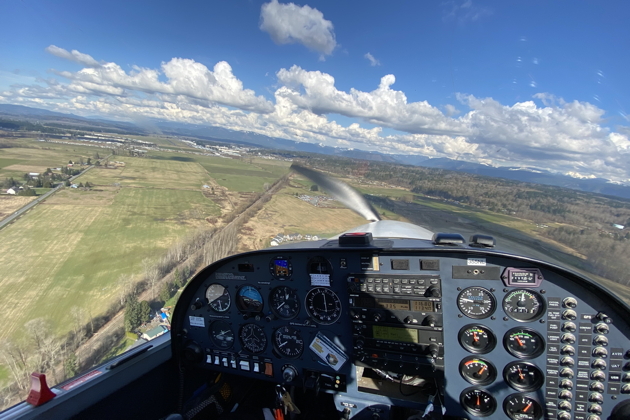FlightLog Archive
∟Aircraft Flown
Flying the Diamond DA20 - Mar 2021
Although you may have spent four long years as a cadet at the USAF Academy, you weren't guaranteed a pilot training slot until you successfully completed the Flight Screening program. Back when I went through the Academy (a long time ago in a galaxy far, far away), the Flight Screening program was conducted while flying the Cessna T-41C, a higher-horsepower 172 configured with a 210-hp IO-360 for the rarified Colorado air. Although the screening program usually involved 25-30 hours of flight time, I felt ripped off when I only received 15 hours of flight time, due to my experience as a cadet soaring instructor. The T-41C was fun to fly, and I wanted more flight time, especially since they were paying for the gas!
In 1993, the USAFA T-41 fleet was replaced with the Slingsby T-3A Firefly for the flight screening role, but the USAFA Slingsby T-3A fleet was grounded and scrapped after a number of fatal accidents. The Air Force now trains all prospective USAF pilots and combat systems officers through a program known as Initial Flight Training, which makes use of the Diamond DA20.
The two-seat DV20 was originally developed and manufactured by the Austrian aircraft manufacturer Diamond Aircraft in the early 90s. Diamond used its experience on the Diamond HK36 Super Dimona motorglider to develop the DV20. Diamond built a Canadian facility for the North American market, and the Canadian-produced aircraft are designated as the DA20 Katana. Diamond's previous sailplane and motorglider design heritage is evident in the DA20's long, graceful wing, sailplane-like T-tail, and bubble canopy.
As I prepared to support DG-1000 sailplane checkouts at Arlington for the Seattle Glider Council, I found out that one of the previous DG-1000 group members owned a DA20, and was looking for a flight refresher after his annual and limited recent flying. Nick Long sent me a copy of the DA20 flight manual, and we agreed to meet on the next good weather day at Arlington.
Nick's DA20 is a Canadian-built DA20-A1, powered by an 80 hp Rotax 912F3, and sporting a constant-speed prop. The DA20-A1 uses a 2.27:1 reduction gearbox to reduce the engine's relatively high 5,800 rpm shaft speed to a more conventional 2,400 rpm for the propeller. Nick and I completed a detailed engine and overall aircraft pre-flight, both to familiarize me with the aircraft, and also to catch any post-annual discrepancies.
Entering the cockpit is straight forward, and I was pleasantly surprised with the shoulder and legroom in the relatively small aircraft. Ground steering is by differential braking, and I noticed my size 12 feet were a bit squeezed in the rudder pedal foot box. Taxiing the Katana in a straight line via differential braking took a bit to get used to, almost as humbling as learning to taxi the Nanchang CJ-6!
Although the winds favored runway 29 at Arlington, Nick wanted to use the full 5300' runway 34 for the first takeoff post-annual, and he did a commendable cross-wind takeoff and climbout. You could feel the gusts with the Diamond's light wing loading, but the ailerons required only slight movements of the stick to correct for the gusts. Nick had mentioned that he had been flying a bit above the recommended approach speed of 57 knots, which is well above the 37 knot stall, causing some extra floating. The first crosswind landing on 34 still had a bit of float, but with the great visibility you can pick and easily anticipate your touchdown point. The fixed landing gear seemed quite strong, obviously built with student training in mind.
I took over the flight controls as we moved to runway 29, and the great bubble canopy helped pick up the seemingly always busy Arlington traffic, especially since both runways 29 and 34 were in use. The flight control harmony felt nice, and a bit of rudder added while starting turns seemed to correct well for the bit of adverse yaw. Due to traffic ahead flying 'bomber patterns', I had a long final to adjust the power, pitch and trim to fly an almost hands-off final, then added a little power for a soft-field landing on runway 29. The DA20 is a joy to fly, and would be fun throttling back and climbing in thermals with that great wing.
Nick flew a few more patterns for his currency, and even in gusty, choppy winds, the airplane performed well, and was quite controllable. Thanks for the DA20 orientation, Nick, and I hope to join you again for a thermaling workout in your Diamond!
 KASPRZYK
KASPRZYK







